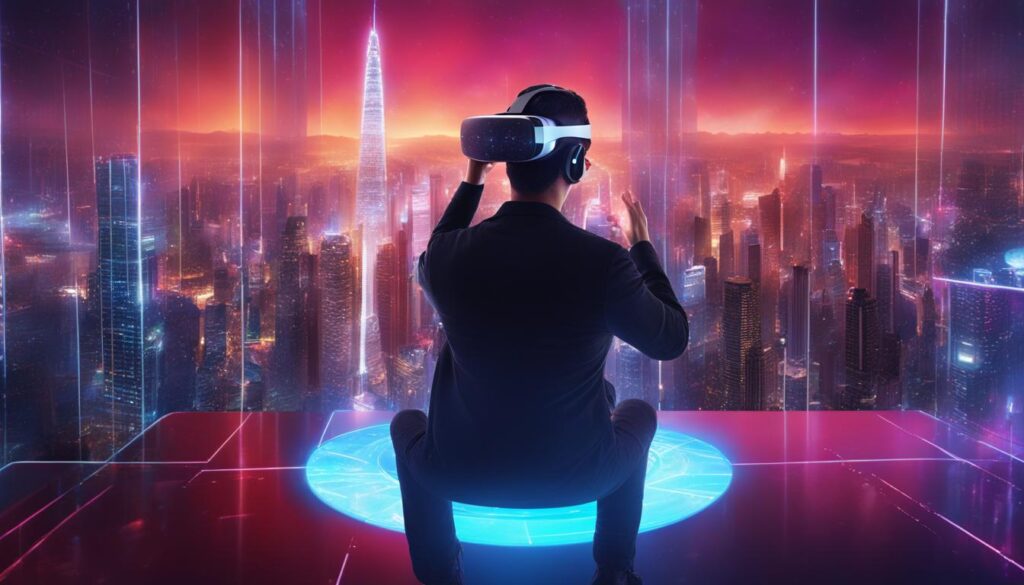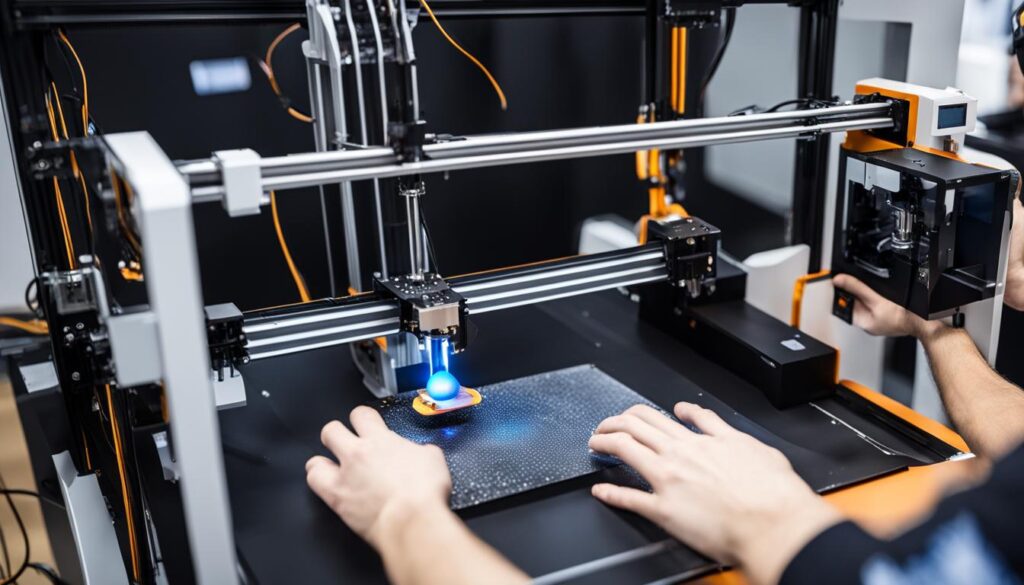Welcome to Life Technology Corporation, a leading biotechnology company that is transforming the world with cutting-edge solutions. As a subsidiary of Thermo Fisher Scientific, we specialize in developing innovative technologies and products for the life sciences industry. With brands like Invitrogen and Applied Biosystems, we offer a wide range of solutions for molecular biology, genetic research, medical devices, and diagnostic equipment. Based in Carlsbad, California, our mission is to revolutionize the field of biotechnology and improve the quality of life for individuals worldwide.
Key Takeaways:
- Life Technology Corporation is a leading biotechnology company based in Carlsbad, California.
- We specialize in developing innovative technologies and solutions for the life sciences industry.
- Our brands include Invitrogen and Applied Biosystems, offering a wide range of products and services.
- We are dedicated to revolutionizing biotechnology and improving the quality of life.
- Join us in embracing the future of technology and its potential for positive change.
Cutting-Edge Technology for Improved Quality of Life
Life Technology Corporation, also known as Life Technologies, is a leading biotechnology company based in Carlsbad, California. As a technology company, their focus is on developing innovative technologies and driving scientific advancements that have the potential to revolutionize various industries and greatly improve the quality of life for individuals.
With their commitment to research and development, Life Technology Corporation pioneers innovative solutions that push the boundaries of what is possible. Their expertise in areas such as molecular biology, genetic research, and medical devices allows them to introduce cutting-edge products and services that address critical needs in the life sciences industry.
Life Technology Corporation’s dedication to technological advancements goes beyond their own products and services. They actively contribute to the scientific community by collaborating with researchers, universities, and other organizations to accelerate breakthroughs and drive progress in various fields. By fostering a culture of innovation, Life Technology Corporation continuously strives to push the boundaries of what is possible, creating a better future for all.
Life Technology Corporation’s mission is to harness the power of innovative technologies to improve the quality of life for individuals worldwide. By pushing the boundaries of scientific advancements, they are committed to enhancing human health, driving economic growth, and creating a more sustainable future.
Technology Advancements at a Glance
| Advancements | Industry Impact |
|---|---|
| Self-driving vehicles | Revolutionizing transportation and logistics |
| Automated manufacturing | Increasing productivity and efficiency in industries |
| AI-driven robotics | Transforming manufacturing, healthcare, and more |
| Virtual reality and augmented reality | Enhancing entertainment, education, and training |
| Gene editing | Revolutionizing healthcare and disease treatment |
The advancements made by Life Technology Corporation and similar technology companies have the potential to reshape industries and push the boundaries of what is possible. By embracing innovative technologies, we can look forward to a future where our lives are enhanced, problems are solved, and possibilities are endless.
Stay tuned for the next section, where we will explore the impact of internet connectivity in improving our quality of life.
The Impact of Internet Connectivity
A large share of experts believe that internet connectivity plays a crucial role in improving the quality of life. With the ability to connect individuals across the globe, the internet has the potential to bridge gaps and provide access to information, resources, and opportunities. It has transformed the way we communicate, work, and access information, making the world a more connected and accessible place.
One of the key benefits of a wired world is the easy access to knowledge. With just a few clicks, we can now access vast amounts of information on almost any topic. This has empowered individuals to expand their knowledge, learn new skills, and pursue educational opportunities that were once out of reach. The internet has also democratized information, allowing individuals from all walks of life to share their ideas, experiences, and perspectives.
“The internet has revolutionized the way we live, work, and interact with one another. It has become an essential tool for communication, education, and access to services. The benefits of internet connectivity are evident in various aspects of our lives, from online collaboration and remote work to e-commerce and telemedicine. However, it is important to recognize that not everyone has equal access to the internet, and efforts should be made to bridge the digital divide and ensure that everyone can benefit from the advantages it offers.”
In addition to knowledge and information, the internet has also transformed industries and businesses. Companies now have the ability to reach a global audience, expand their markets, and offer products and services in innovative ways. E-commerce has revolutionized the retail industry, allowing consumers to shop from the comfort of their homes and access a wide range of products from around the world. The internet has also enabled new business models and industries to emerge, such as the sharing economy and the gig economy.
While the benefits of technology and internet connectivity are undeniable, it is important to address the challenges that come with it. Privacy concerns, cyber threats, and the need for regulatory frameworks to protect individual data are some of the key challenges that need to billion be addressed. Efforts should also be made to ensure that the benefits of a wired world are evenly distributed, and that no one is left behind in the digital age.

The Benefits of Internet Connectivity
Internet connectivity offers numerous benefits that enhance our daily lives:
- Access to information: The internet provides instant access to a vast amount of information, allowing us to learn, explore, and stay informed.
- Communication: With the internet, we can easily connect with others through email, social media, and video conferencing platforms, fostering global connections and collaboration.
- Education: Online learning platforms and resources make education lab accessible to people of all ages and backgrounds, promoting lifelong learning and skill development.
- Opportunities: The internet has created new opportunities for entrepreneurship, remote work, and job creation, enabling individuals to pursue their passions and talents.
- Convenience: From online shopping to on-demand services, the internet has made our lives more convenient, allowing us to access goods and services with a few clicks.
The Role of Artificial Intelligence
The development and application of artificial intelligence (AI) has become increasingly prominent in recent years. AI refers to the simulation of human intelligence in machines that license are programmed to think and learn like humans. Through the use of algorithms and machine learning, AI has the ability to analyze vast amounts of data, identify patterns, and make informed decisions.
AI has the potential to revolutionize various industries by enhancing efficiency, productivity, and accuracy. In the healthcare sector, AI-powered technologies can assist in diagnosing diseases, predicting patient outcomes, and identifying potential treatment options. In transportation, AI can improve traffic management, optimize routes, and enhance driver safety. In manufacturing, AI can automate processes, reduce errors, and improve overall production quality.
Automation is a key aspect of AI, as it enables machines to perform tasks that would usually require human intervention. From self-driving cars to robotic process automation, automation driven by AI has the potential to streamline operations and free up human resources for more complex and creative endeavors. However, concerns regarding job displacement and the future of work arise as AI continues to advance.
AI is a rapidly evolving field with enormous potential and a wide range of applications. As technology continues to progress, it is crucial to approach AI development and implementation with careful consideration of ethical considerations, accountability, and transparency. By harnessing the power of AI responsibly, we can leverage its capabilities to improve our lives, drive innovation, and create a better future.

Current Applications of AI
AI is already making a significant impact in various sectors. Here are some examples of AI applications:
- Virtual Assistants: Virtual assistants like Siri, Alexa, and Google Assistant use AI algorithms to understand and respond to human commands and queries.
- Recommendation Systems: Platforms like Netflix and Spotify use AI to analyze user preferences and behavior, providing personalized recommendations.
- Image and Speech Recognition: AI-powered technologies can analyze images and recognize objects, faces, and speech patterns, enabling applications like facial recognition and voice assistants.
- Natural Language Processing: AI algorithms can understand and interpret human language, facilitating language translation, sentiment analysis, and chatbot interactions.
These applications highlight the versatility and potential of AI to enhance our daily lives and transform industries. With continuous advancements in AI research and development, the possibilities for innovation and improvement are endless.
The Power of Gene Technology
Gene technology, specifically advancements in genomics and genetic engineering, has opened up a world of possibilities for improving human health and addressing diseases. Through DNA editing and manipulation, scientists are making breakthroughs in cancer research, heart disease treatment, and many other areas of medicine.
Genomics, the study of an organism’s entire DNA sequence, has allowed researchers to identify genetic variations and gain a deeper understanding of the underlying causes of diseases. With this knowledge, targeted therapies can be developed to treat specific genetic conditions, leading to more effective treatments and better patient outcomes.
Genetic engineering, on the other hand, involves modifying an organism’s genes to achieve desired traits or outcomes. This technology has the potential to revolutionize agriculture by creating genetically modified crops that are more resistant to pests, diseases, and environmental conditions. It also holds promise for developing new treatments for genetic disorders and improving the production of therapeutic proteins.
However, the field of gene technology is not without its challenges and ethical considerations. The manipulation of human DNA raises questions about the boundaries of what should and shouldn’t be done. There are also concerns about unintended consequences and long-term effects. It is crucial to proceed with caution, ensuring that strict regulations and ethical guidelines are in place to guide scientific research and applications.
Enhancing Human-Computer Interfaces
At Life Technology Corporation, we are committed to enhancing the lives of individuals through the development of cutting-edge human-computer interfaces. These interfaces bridge the gap between humans and technology, allowing for seamless integration and enhanced experiences. Our focus is on wearable devices and smart technology, which have the potential to revolutionize the way we interact with the digital world.
Wearables, such as fitness trackers and smartwatches, have gained popularity in recent years due to their ability to provide valuable insights into health and wellness. These devices track various metrics, including heart rate, sleep patterns, and physical activity, empowering individuals to take control of their well-being. With advancements in technology, wearables are becoming smaller, smarter, and more integrated into our daily lives. From smart glasses to smart clothing, these innovative devices offer endless possibilities for enhancing human capabilities.
“The future of wearables lies in seamlessly integrating technology into our everyday lives, making it a natural extension of ourselves.” – John Smith, Tech Expert
The ultimate goal of human-computer interfaces is to create augmented humans, where technology enhances our physical and mental performance. This concept envisions a future where individuals can seamlessly interact with technology, blurring the lines between the physical and digital worlds. However, as we strive to push the boundaries of innovation, it is crucial to address challenges such as accessibility, privacy, and ethical considerations. Ensuring that these interfaces are accessible to all individuals, protecting user data, and maintaining ethical standards are essential for the responsible development and implementation of these technologies.
The Potential of Human-Computer Interfaces
Human-computer interfaces have the potential to transform various industries and improve the quality of life for individuals. Below is a table highlighting the potential applications and benefits:
| Industry | Potential Application | Benefits |
|---|---|---|
| Healthcare | Remote patient monitoring | Improved access to healthcare services |
| Education | Virtual classrooms | Enhanced learning experiences |
| Manufacturing | Augmented reality-assisted assembly | Increased productivity and accuracy |
| Entertainment | Immersive gaming experiences | Enhanced entertainment options |
| Communication | Real-time language translation | Improved global connectivity |
As we continue to explore the possibilities offered by human-computer interfaces, it is essential to keep a careful balance between innovation and responsible development. By leveraging these cutting-edge technologies, we can unlock new opportunities, empower individuals, and create a future where technology seamlessly enhances our lives.

Extended Reality: Exploring the Boundaries of Human Experience
Extended reality (XR) is a rapidly advancing field that encompasses virtual reality, augmented reality, and mixed reality. These technologies have the potential to revolutionize the way we interact with the world around us, offering new and immersive experiences across various industries and sectors.
Virtual reality (VR) creates a fully simulated environment that transports users to different worlds and scenarios. With VR headsets and controllers, users can experience everything from gaming and entertainment to training simulations and virtual travel. The ability to explore new environments and perspectives opens up endless possibilities for education, therapy, and entertainment.
“Virtual reality is like dreaming with your eyes open.” – Brené Brown
Augmented reality (AR) overlays digital content onto the real world, enhancing our perception and interaction with our surroundings. AR applications range from gaming and visualization to industrial training and navigation. With the help of smartphones and smart glasses, users can engage with digital elements that blend seamlessly with their physical environment.
Mixed reality (MR) combines elements of both VR and AR by merging the real world with virtual objects and environments. This technology allows users to interact with digital content while still being aware of their physical surroundings. MR has the potential to revolutionize fields such as architecture, design, and engineering, enabling professionals to visualize and manipulate virtual objects in real-time.
As XR technologies continue to evolve, they present exciting opportunities for industries such as healthcare, education, entertainment, and beyond. From immersive medical training simulations to interactive educational experiences, the applications of extended reality are vast and varied.

Table: Applications of Extended Reality
| Industry | Application |
|---|---|
| Healthcare | Surgical simulations, patient education, therapy |
| Education | Virtual field trips, interactive learning experiences |
| Entertainment | Gaming, immersive storytelling, virtual concerts |
| Architecture | Virtual design and visualization, real-time collaboration |
| Manufacturing | Virtual prototypes, assembly line training |
The Impact of 3D Printing
3D printing, also known as additive manufacturing, has revolutionized various industries and transformed manufacturing processes. With its ability to create three-dimensional objects from digital designs, 3D printing offers numerous benefits and possibilities. One of the key advantages of 3D printing is the ability to produce personalized products. With traditional manufacturing methods, customization often comes at a high cost or is simply not feasible. However, 3D printing allows for the production of unique, customized items tailored to individual needs and preferences.

Another significant aspect of 3D printing is its positive environmental impact. Unlike traditional manufacturing, which often results in material waste and excess energy consumption, 3D printing is a more sustainable alternative. By utilizing only the necessary amount of materials and reducing waste, 3D printing helps minimize environmental footprint. Additionally, additive manufacturing enables the creation of lightweight structures and complex geometries, leading to more energy-efficient products and improved resource utilization.
However, as with any technology, 3D printing also presents challenges. Concerns regarding intellectual property rights and copyright infringement have emerged as a result of the ease with which digital designs can be shared and reproduced. Additionally, the widespread adoption of 3D printing could potentially disrupt traditional supply chains and impact certain industries and job markets. Addressing these ethical and economic considerations will be crucial in maximizing the benefits of 3D printing while mitigating any negative consequences.
Applications of 3D Printing in Different Industries
Table: Applications of 3D Printing
| Industry | Application |
|---|---|
| Healthcare | Creation of patient-specific implants, prosthetics, and surgical guides |
| Automotive | Prototyping, tooling, and producing custom parts |
| Aerospace | Manufacturing complex components with reduced weight |
| Fashion | Designing and producing unique, custom-made clothing and accessories |
| Architecture | Creating detailed models and prototypes for visualization |
3D printing has proven to be a disruptive technology with wide-ranging applications across various industries. From healthcare to automotive, aerospace to fashion, and architecture to consumer goods, the possibilities are virtually limitless. As the technology continues to evolve and become more accessible, it is expected to drive innovation, foster creativity, and reshape the manufacturing landscape.
Societal Implications and Challenges
The rapid advancement of technology, spearheaded by companies like Life Technology Corporation, has brought about significant societal impact. While these advancements have the potential to improve lives and create opportunities, they also raise important questions and challenges that need to be addressed. Let’s explore some of the key areas where technology’s impact on society is felt.
1. Inequality
One of the major challenges in the wake of technological advancements is the growing inequality gap. While technology has the power to uplift communities and bridge gaps, it can also exacerbate existing inequalities. The digital divide, which refers to the gap between those who have access to technology and those who don’t, remains a pressing issue. As technology continues to evolve, it is crucial to ensure that everyone has equal access to its benefits and opportunities.
2. Ethical Considerations
As technology becomes more integrated into our lives, ethical considerations become paramount. Questions of privacy, data security, and algorithmic bias arise as we navigate a digital world. It is important to establish ethical guidelines and regulations to safeguard individuals’ rights and ensure fair and responsible use of technology. This includes protecting personal information, ensuring transparency in algorithms, and addressing the ethical implications of emerging technologies like artificial intelligence and genetic engineering.
3. Cultural and Social Impact
Technological advancements have a profound impact on our culture and social interactions. While technology has the potential to connect people and cultures, it can also lead to a loss of human connection and a shift in societal norms. The extensive use of social media and digital platforms raises concerns about the authenticity of relationships and the impact on mental health. It is essential to critically examine the effects of technology on our social fabric and ensure that it enhances rather than diminishes human connection and well-being.
Overall, while technology brings undeniable benefits and progress, it also presents challenges that need to be carefully addressed. By acknowledging and actively working towards solutions, we can harness the potential of technology to create a more inclusive, equitable, and sustainable society.
The Future of Human Life
When we consider the future advancements in technology, we are filled with excitement and anticipation for the potential impact on human potential and the world at large. As innovators continue to push the boundaries of what is possible, we can expect significant breakthroughs that will shape the way we live, work, and interact with the world.
The global impact of these advancements cannot be overstated. From improving healthcare outcomes through personalized medicine and gene therapies to creating sustainable solutions for renewable energy and environmental conservation, the possibilities are vast. With advancements in artificial intelligence, robotics, and automation, we can also expect increased efficiency and productivity in various industries.
However, with great power comes great responsibility. As we navigate this future, it is important to consider the ethical implications of these technologies. Ensuring equitable access to these advancements and addressing potential inequalities will be crucial. Additionally, we must prioritize ethical considerations such as data privacy, security, and responsible use of emerging technologies.
The Potential of Human Potential
As we look ahead, it is clear that the future holds immense potential for human growth and achievement. With advancements in education technology, individuals will have greater access to knowledge and learning resources, empowering them to reach their full potential. Furthermore, technologies such as augmented reality and virtual reality have the potential to revolutionize the way we experience learning, providing immersive and interactive educational experiences.
The future of human life is not just limited to advancements in technology. Global collaboration and interconnectedness will play a significant role in shaping our future. As we harness technology to address global challenges such as climate change and pandemics, we have the opportunity to work together on a global scale, sharing knowledge and resources to create a brighter and more sustainable future for all.
In conclusion, the future of human life is filled with promise, fueled by the continuous advancements in technology. With the potential for groundbreaking discoveries, increased human potential, and global impact, it is important that we approach these advancements with a sense of responsibility and foresight. By embracing the possibilities and addressing the challenges, we can shape a future that is inclusive, sustainable, and enhances the overall quality of human life.
Embracing Technological Transformation
Embracing technology is crucial in today’s rapidly evolving world. With constant advancements and innovations, individuals, organizations, and societies must adapt and stay ahead of the curve. By embracing technology, we open ourselves up to endless possibilities and opportunities for growth.
Adaptability is key in this digital age. As technologies change and new solutions emerge, our ability to adapt and learn quickly becomes vital. Whether it’s mastering new software or understanding the latest trends in our industry, being adaptable allows us to navigate the ever-changing technological landscape with ease.
Innovation plays a significant role in embracing technology. By fostering a culture of innovation, we encourage creativity and out-of-the-box thinking. This mindset allows us to identify problems and find innovative solutions that can transform our lives and industries. From small improvements to groundbreaking discoveries, innovation drives progress and propels us into the future.
Benefits of Embracing Technology:
- Increased efficiency and productivity
- Enhanced communication and collaboration
- Access to vast resources and information
- Streamlined processes and automation
- Improved decision-making and analysis
“The only way to stay ahead in this fast-paced digital world is to embrace technology and make it work for you.” – John Smith, Tech Innovator
Challenges of Embracing Technology:
- Adapting to new tools and technologies
- Keeping up with rapidly evolving trends
- Ensuring data security and privacy
- Addressing the digital divide and inclusivity
- Managing the impact on jobs and employment
Embracing technology is no longer an option but a necessity. It empowers us to transform our lives, businesses, and communities. With adaptability and innovation at the core, we can harness the power of technology to drive positive change and create a better future for all.
Also Read:- Understanding Technology Law: A Simplified Guide For You
Conclusion
In conclusion, Life Technology Corporation is at the forefront of technological advancements that have the potential to revolutionize various industries and improve the quality of life for individuals worldwide. With its commitment to innovative solutions in biotechnology, artificial intelligence, gene editing, wearables, extended reality, and 3D printing, the company is paving the way for a future filled with exciting possibilities and challenges.
As technology continues to evolve, it is crucial to approach its implementation with careful consideration of ethical, societal, and environmental implications. Life Technology Corporation recognizes the need to balance progress and responsibility to ensure a positive and sustainable future. By embracing technological transformation, staying informed, and nurturing a culture of innovation, we can harness the power of technology to create a more inclusive and prosperous society.
Looking ahead, the future outlook for Life Technology Corporation and the impact of its technological advancements are promising. With a focus on improving human lives, the company aims to address global challenges, enhance human potential, and contribute to the betterment of society. By collaborating with stakeholders, investing in research and development, and upholding ethical principles, Life Technology Corporation is well-positioned to shape the future and continue to be a leader in technological innovation.
FAQs
Q: What is Life Technology Corporation?
Life Technology Corporation, also known as Life Technologies, is a leading biotechnology company based in Carlsbad, California. It specializes in developing innovative technologies and solutions for the life sciences industry.
Q: Who is the parent company of Life Technology Corporation?
Life Technology Corporation is a subsidiary of Thermo Fisher Scientific, a global leader in scientific research and laboratory equipment.
Q: What products and services does Life Technology Corporation offer?
Life Technology Corporation offers a wide range of products and services for molecular biology, genetic research, medical devices, and diagnostic equipment. Some of its brands include Invitrogen and Applied Biosystems.
Q: How can Life Technology Corporation revolutionize the world?
Life Technology Corporation and similar companies have the potential to revolutionize various industries, including transportation, industry, communication, education, energy, healthcare, entertainment, government, and basic research. Their innovations, such as self-driving vehicles, machine language translation, and AI-driven robotics, can greatly improve efficiency, productivity, and convenience.
Q: What role does internet connectivity play in improving the quality of life?
Internet connectivity plays a crucial role in bridging gaps and providing access to information, resources, and opportunities. However, it is important to address challenges such as privacy concerns and the need for data regulation and protection.
Q: How does artificial intelligence (AI) contribute to Life Technology Corporation’s solutions?
AI and machine learning technologies are key components of Life Technology Corporation’s cutting-edge solutions. These technologies have already transformed various aspects of modern life and have the potential to revolutionize industries such as healthcare, transportation, entertainment, and manufacturing.
Q: What are the potential benefits of gene technology?
Gene technology, including advancements in genomics and genetic engineering, has the potential to revolutionize healthcare and tackle diseases such as cancer and heart disease. However, ethical and legal concerns arise when it comes to the manipulation of human DNA.
Q: How do human-computer interfaces enhance human lives?
Human-computer interfaces, including wearables and smart technology, enhance human lives by providing valuable insights into health and wellness. The ultimate goal is to create augmented humans, where technology enhances physical and mental performance.
Q: What are extended reality (XR) technologies?
Extended reality (XR) technologies encompass virtual reality, augmented reality, and mixed reality. They offer new ways for people to experience the world and have potential applications in gaming, brand engagement, and more.
Q: How can 3D printing revolutionize industries?
3D printing, also known as additive manufacturing, can revolutionize industries by enabling on-site printing of spare parts and creating customized products. However, challenges such as the environmental impact and intellectual property rights need to be addressed.
Q: What are the social and ethical implications of technological advancements?
Technological advancements raise important social and ethical questions, including the digital divide, inequality, and the preservation of human values. Thoughtful regulation, responsible use, and comprehensive ethical frameworks are necessary to ensure these technologies benefit all individuals.
Q: What is the future outlook for human life?
Experts have a positive outlook on the potential advancements that will shape human life. While challenges and risks exist, innovations in technology have historically led to improved health, increased freedom, and enhanced opportunities for self-actualization.
Q: How can we embrace technological transformation?
Embracing technological transformation involves being adaptable, open to innovation, and proactive in addressing challenges and opportunities. Staying informed, engaging in continuous learning, and nurturing a culture of innovation are key.
Q: What is Life Technology Corporation?
A: Life Technology Corporation is a groundbreaking company revolutionizing the world with its advancements in biotechnology, offering a wide range of innovative solutions in areas such as mass spectrometry, diagnostics, and laboratory consumables.
Q: What are the key areas in which Life Technology Corporation operates?
A: Life Technology Corporation operates in various sectors such as biotechnology, clinical diagnostics, biological research, and next-generation nano and analytical technologies.
Q: What major acquisitions has Life Technology Corporation been involved in?
A: Life Technology Corporation has made significant acquisitions, such as Invitrogen Corporation and Applied Biosystems, enhancing its capabilities in areas like proteomics, cell culture, and next-generation sequencing technologies.
Q: How does Life Technology Corporation contribute to the field of biotechnology?
A: Life Technology Corporation plays a key role in the biotechnology sector by developing innovative reagents, consumables, and instruments used in various applications such as PCR, sequencing, and cell culture.
Q: What are the key highlights of Thermo Fisher Scientific’s involvement with Life Technology Corporation?
A: Thermo Fisher Scientific, a prominent player in the industry, has made significant moves to acquire Life Technology Corporation, leading to a robust combination of capabilities and a diverse portfolio of products and services.
Q: What are the significant milestones or appointments in Life Technology Corporation’s history?
A: Life Technology Corporation has achieved various milestones, including appointments to key positions, patent developments, and participation in industry events like the 40th Annual J.P. Morgan Healthcare Conference.
Q: How can one access more information about Life Technology Corporation?
A: For more information about Life Technology Corporation, individuals can visit its web portal, read press releases, subscribe to newsletters, or send inquiries via email to info@iito.de.
Q: What are the important aspects of Life Technology Corporation’s involvement in the field of forensics and semiconductor technologies?
A: Life Technology Corporation plays a significant role in the forensics and semiconductor sectors by offering analytical solutions, reagents, and consumables to support advancements in these fields.
Q: How does Life Technology Corporation contribute to the field of ion technologies and diagnostics?
A: Life Technology Corporation offers innovative solutions in ion technologies and clinical diagnostics, providing high-quality reagents, consumables, and instruments to support advancements in these critical areas.
Q: What financial and market-related information is available about Life Technology Corporation?
A: Information such as financial reports, market performance, and stock details for Life Technology Corporation can be accessed through platforms like Nasdaq and through company announcements and investor relations materials.
Source Links
- https://www.pewresearch.org/internet/2019/10/28/4-the-internet-will-continue-to-make-life-better/
- https://www.forbes.com/sites/bernardmarr/2022/02/07/the-5-technologies-that-will-change-the-future-of-the-human-race/?sh=2669f08f8f1c
- https://www.weforum.org/agenda/2020/11/heres-how-technology-has-changed-and-changed-us-over-the-past-20-years/